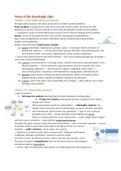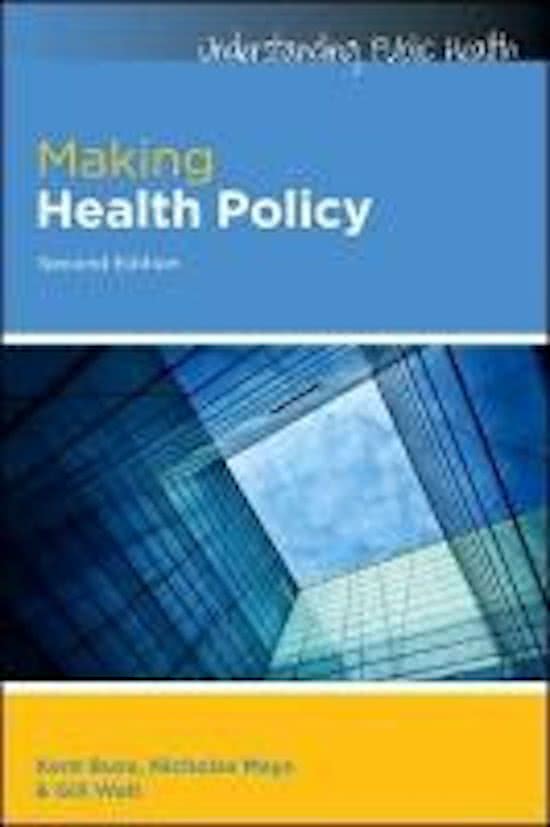Notes of the knowledge clips
Chapter 1: The health policy framework
Strategic policy analysis and advice is necessary to battle societal problems.
Policy problem = (1) gap between the ideal world and current reality, (2) reason for this
difference is unclear, (3) there should be more than one possible solution to the problem.
→ a purposive couse of action followed by an actor/set of actors in dealing with a problem.
Means = series of intended activities with certain consequences (instruments) →
types: judicial (legislation), economic (subsidies/taxes), communication (persuasion),
modern (self regulation).
Simple relational model: health policy triangle =
(a) actors: individuals, organisations, groups, states → inside government; members of
parliament, ministers → outside government; groups that don’t seek political power, but
seek influence (FEX. civil society organisations, NGOs, private companies).
→ macro level: political (steers the whole society) -> meso level: institutional (groups of people) ->
micro level: societal (individuals).
(b) context: situational factors; focusing events, violent events (wars), natural disasters, new
disease epidemic → structural factors; political system, type of economy, tech, GNP,
demography, migration → cultural factors; religion, traditional, social values →
international factors; exogenous, interdependence among states, multilateral aid.
(c) process: stages of policy making; problem identification, policy formulation, policy
implementation, policy evaluation, feedback and policy terminatioon.
(d) content: what is the issue, why is something not working? → data analysis, actor chart,
labeling, causal analysis.
Chapter 10: Doing policy analysis
2 types of analysis:
1. Retrespective analysis: learning from the past, analysis of existing policy.
2. Prospective analysis: advicing the present, analysis for new policy,
change and reform.
Always important to study the stakeholders → stakeholder analysis = (a)
identify actors, (b) assess power relationships, (c) assess interests, positions
and commitment, and (d) assess the opposition → type of actor analsysis
(example picture left) → arrows between actors indicate the power.
There is a relation between power and position → actors might shift to higher
and lower power positions → especially the neutral power group.
Strategies for policy change: funds, personnel and facilities → info to increase expertise → access
to decision makers and media (who needs to be followed when we want to
change?) → public relations; victum status, hero status.
→ legislators are influenced by: direct contacts (FEX. lobbyists and business
coalitions), idiologies and beliefs, consumers and the media.
Literature review: be efficient in time, collect only data that matters, check
literature of experts (triangulation), look for the best practices and analogies
and ask key players (opposition).
→ picture right: develop policy instruments to change opposition into supporters.
, Chapter 4: Agenda setting
Agenda setting:
- Rational model = choose what is important (but this may differ per group).
- Hall model = 3 features; legitimacy (have to), feasibility (can we), support (will we).
- Kingdon’s stream model = 3 separate streams of processes; problem stream, policy
stream (solution), politics stream (will), that come together, creates a policy window.
- Hogwood & Gunn approach = issue search”, anticipate before problems turn into crisis.
- Shiffman & Smith’s model = policy making influenced by; actor power (strength of actors),
ideas (how they protray), context (featuring problems), characteristics → internal frame =
policy stream → external frame = politics stream.
Chapter 6: Interest groups and the policy process
Interest groups = non-governmental, involved in policy process to influence government
thinking → shift from government to governance: shift from traditional hierarchical and directive
mode towards adoption of networks of government, civil society and private sector → more
participatory relation between state and society → more flexible forms of regulation.
→ 3 features: (1) voluntary, (2) aim to achieve desired goals, (3) do not aim to conform to a part of
the government machinery (want to influence the government from the outside).
Not all civil society groups are interest groups: policy issues are not for all groups central to their
identity → FEX. for sportclubs → interest groups are related to market activities.
Sectional groups = protect interests of their members and political pressure is secondary aim →
very influential (FEX. trade unions) → in the health sector, medical professionals.
Cause groups = pressurise particular issues and draw their membership from a wide range of
people in society → FEX. environmental organisations, consumer groups, etc.
The influence of interest groups depends on their resources, such as: members, level of funding,
level of knowledge, persuasive skills, sanctions → the more members, the more influence.
Insider groups = accepted and respected by government policy makers → part of governmental
decision-making (FEX. through government committees) → often subtle lobbying.
Outsider groups = not perceived as legitimate by the government → difficulty in penetrating
policy process → resort to direct action (FEX. demonstration) to raise awareness.
→ thresholder groups: can shift strategies over time, from outsider to insider group.
Benefits interest groups: participation (alternative way for voters) - representation (widens range
of options) - political education (learn about policy process) - motivation (bring in new issues and
info) - mobilisation (build pressure of action) - monitoring (assessing performance of
government) - provision (deliver services).
Interest groups lobby → lobbyists = professional persuaders to take up certain causes → high
academic profile, possess relevant info and represent a substantial actor group → seek close
relationship with civil servants.
How do government and interest groups meet: policy sub-communities = special small and stable.
→ iron triangle = relationships between politicians, bureaucrats and industry (long history, meet
frequently and discuss relevant issues in their field).
→ issue networks = loosely interdependent, ubstable networks, many members whose
interactions fluctuates → meet when an issue arises and help with agenda setting.
→ FEX. the health reform issue connects professional monopolists (doctors), corporate
rationalists (insurers, hospital chains) and equal health advocates (patient groups).






